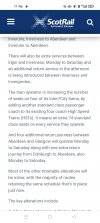ScotRail's 158 fleet is split between 2 depots, Inverness and Corkerhill (formerly Haymarket). With the exception of the Far North line (which require RETB signalling which only the Inverness units are fitted with), they run interchangabley on all other routes 158s operate.
Difference between them is the high refurbishment standard. Inverness 158s were refurbished in the First days ~2007
to a very high standard, whereas the Haymarket (now Corkerhill) sets
were left untouched. In recent refreshes the Inverness sets just got the
new colour scheme touch up and a deep clean as well as a few minor modifications. Recently, the Corkerhill sets were refurbished, but
not to the same standard, leaving a difference between the 2 in terms of seating provision, ambience, luggage space, legroom, and bike space.
Whilst it's up for debate which of the two are better, some (including myself) would argue the Inverness 158s are better than a ScotRail HST for standard class (bigger tables, greater legroom, more toilets, greater luggage and bike space, USBs provided in addition to plugs).

